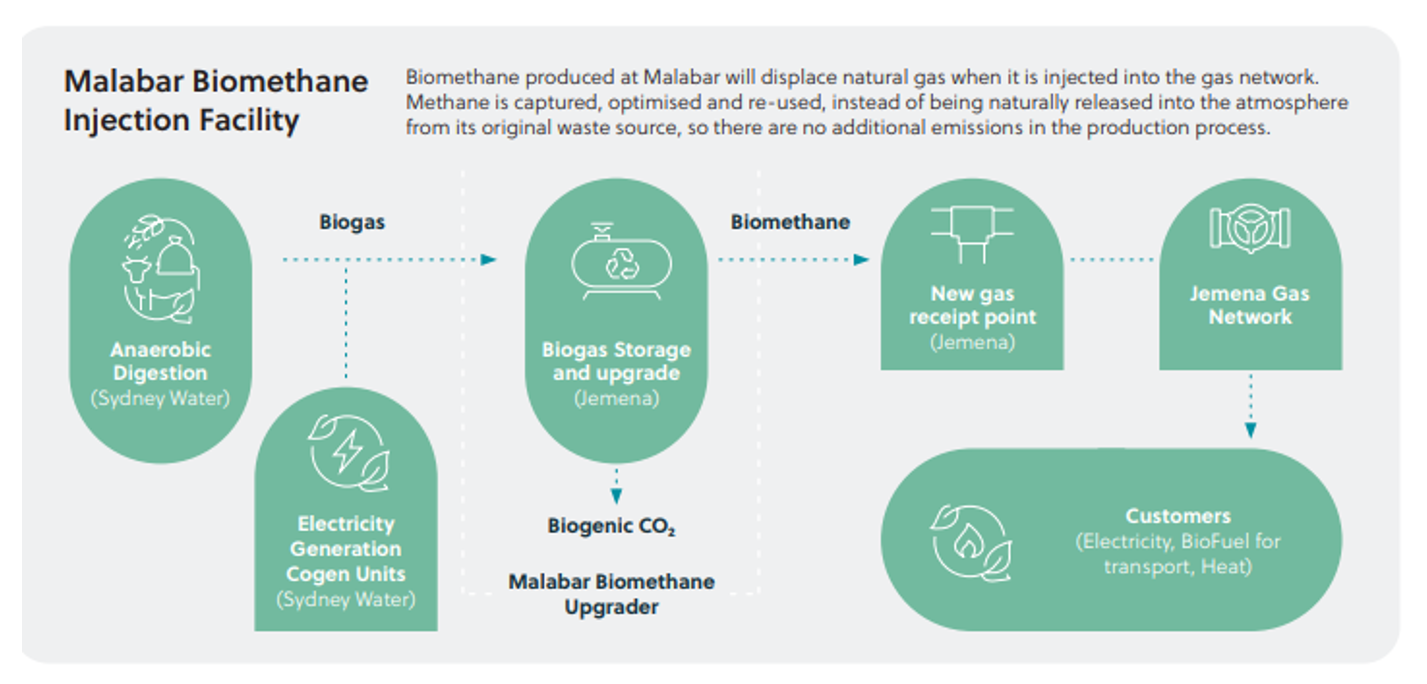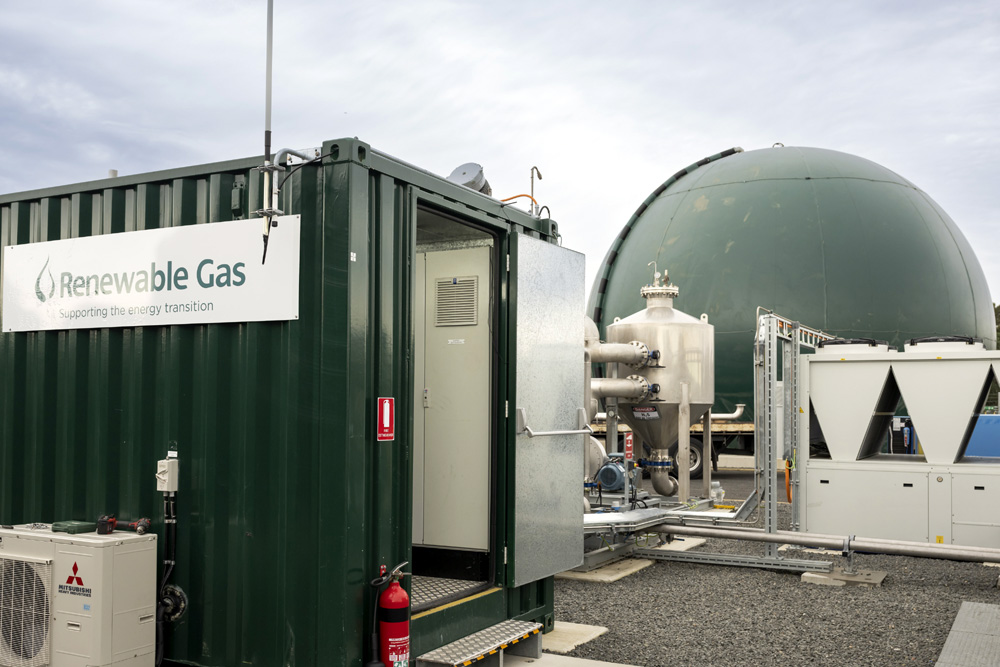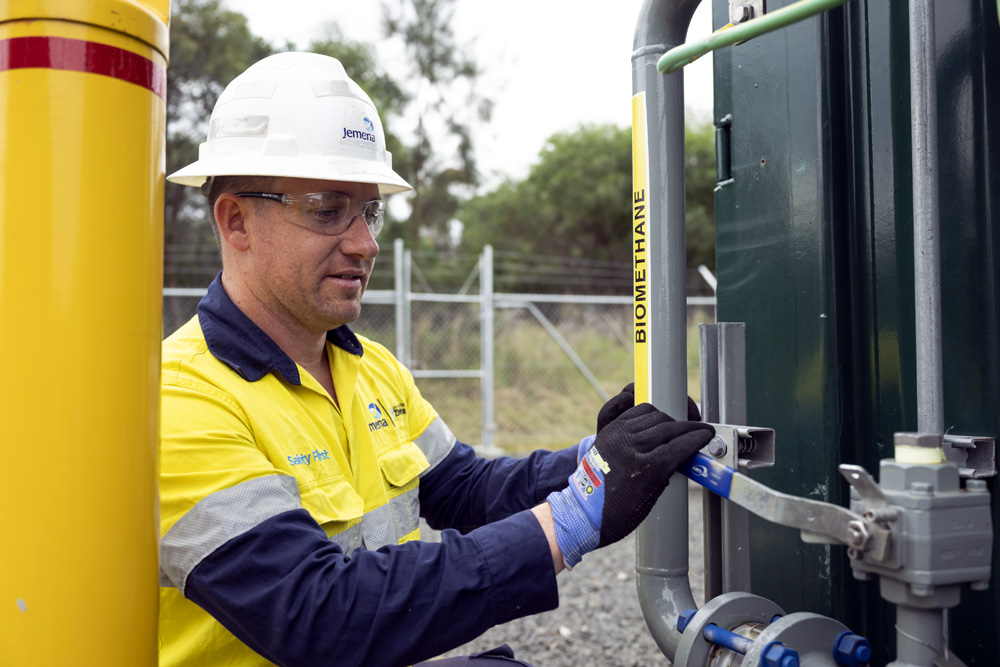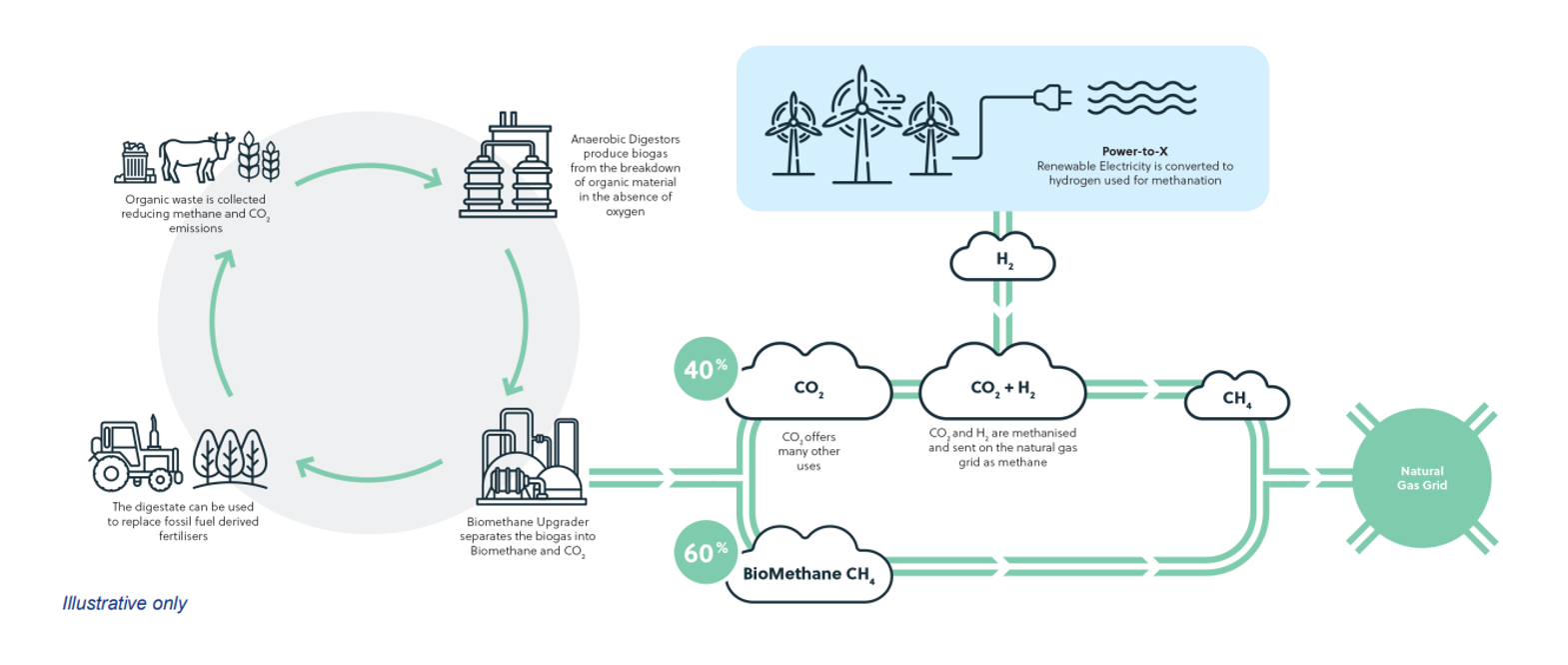Malabar Biomethane Facility
What is biomethane?
Biogas is derived from plant and animal by-products, agriculture, farming, forestry and human wastes. Biogas is produced through a process called anaerobic digestion, where bacteria breaks down organic waste and gas is released. This can be processed further to produce biomethane that meets the gas quality specifications for injecting gas into the existing gas distribution network.
It helps create circular economies, reduce waste, has a number of potential renewable energy applications, and its by-product can even help fertilise crops.

Biomethane’s Potential in Australia
The bioenergy sector, including biomethane, has the potential to offer significant employment and economic benefits. ARENA’s 2021 Bioenergy Roadmap projects that by 2030, the bioenergy sector will not only enhance Australia’s fuel security but also contribute to around $10 billion in extra GDP per annum, create 26,200 new jobs, reduce emissions by around 9 per cent, and divert an extra 6 per cent of waste from landfill.
Biomethane is already used widely in many countries, particularly in Europe.
In Denmark, for example, biomethane supplied more than 25% of gas demand in 2021, and this is projected to increase to more than 70% by 2030.
Our Managing Director, Frank Tudor, spoke about the potential for biomethane at the 2023 Australian Domestic Gas Outlook in March. His presentation is available here.


Turning wastewater into energy
At the Malabar facility, Jemena has partnered with Sydney Water to upgrade biogas produced from organic waste at the Malabar Water Resource Recovery Facility (WRRF) to a quality that meets the required specifications (Australian Standard AS4564:2020) for injection into the natural gas network as compliant gas.
The Malabar WRRF is located in the Malabar Headland National Park, and is one of Sydney Water’s multiple Anaerobic Digestion (AD) plants in NSW which produce biogas from organic waste in waste water. Before the development of the biomethane injection facility, the bulk of the AD biogas output was used for electrical power generation and water heating on site. The balance of biogas that could not be used via site processes was combusted through waste gas burners.
Jemena, as the owner of the NSW gas network, seeks to understand and develop technologies that allow for a transition to a lower emissions gas network, whilst delivering a competitive and sustainable gas consumer product. Jemena believes that technologies exist today that can be deployed in Australia to increase the domestic supply of Biomethane and other forms of Renewable Gas such as Renewable Hydrogen and Synthetic Methane.
The project is jointly funded by Jemena and the Australian Renewable Energy Agency (ARENA) which is contributing up to $5.9 million in grant funding.
The Malabar Biomethane Injection Plant is aiming to be registered under GreenPower’s renewable gas certification pilot scheme.
Origin Energy has signed an offtake agreement with Jemena to purchase all the biomethane produced at the plant in the first 18 months of operation.

How much Renewable Gas is being produced?
The project has an initial capacity of 95 terajoules of renewable gas per annum. This is about equivalent to the average annual gas usage of 6,300 NSW homes.
How is biomethane produced onsite?
Key infrastructure built onsite for the project includes:
A biomethane upgrader:
Biomethane upgraders remove water, carbon dioxide, and other contaminants from biogas to produce renewable natural gas (biomethane). The removed contaminants are appropriately managed according to their characteristics, with fluids returned to the Sydney Water drainage system, hazardous gases absorbed via carbon filters and disposed of with the necessary waste classification and the biogenic carbon dioxide (CO2) – that is, the CO2 which would have been released during the waste’s life cycle - is vented into the atmosphere.
Biogas buffer storage:
This biodome stores the biogas produced from wastewater, before it’s upgraded into biomethane. The biodome is constructed from materials that are flame retardant, abrasion-resistant and UV/sun resistant, preventing deterioration of the material over the lifecycle of the equipment.
Construction and Community Engagement
The Review of Environmental Factors for this project was released in September 2021, and members of the community were asked to provide feedback by 8 October 2021. Feedback from the community was also sought at a public forum in March 2021, and letterbox notification updates were provided to nearby residents as we moved through the different stages of project construction. Sydney Water’s Community Reference Group (CRG) for the Malabar WRRF has also been used to share information with the local community. Our project team responds to emails from the local community via our email address malabarproject@jemena.com.au. Following completion of construction, members of the community were invited to a further Community Information Session in March 2023.
The Review of Environmental Factors is available here.
The updated Review of Environmental Factors Addendum is available here.
If you would like to contact us directly, please email pipelines.commercial@jemena.com.au
Gas Market Code information disclosure
The information disclosed below is published by Jemena Malabar Pipeline Pty Ltd (‘Jemena Malabar') for the purposes of section 34 of the Competition and Consumer (Gas Market Code) Regulations 2023.
This information was last updated on 27 March 2024.
The following tables are approved by the ACCC for the purposes of section 34 (10)(b) of the Competition and Consumer (Gas Market Code) Regulations
2023.
| This table is approved by the ACCC for the purposes of section 34(10)(b) of the Competition and Consumer (Gas Market Code) Regulations 2023 | |||||||||||||||||||||||||||||||
| PART A: INFORMATION RELATING TO AVAILABLE GAS AND EOIs | |||||||||||||||||||||||||||||||
| 24 month period start date: DD-MM-YYYY Refer to subsection 34(1)(b) |
01-04-2024 | ||||||||||||||||||||||||||||||
| 24 month period end date: DD-MM-YYYY |
31-03-2026 | ||||||||||||||||||||||||||||||
| AVAILABLE GAS | |||||||||||||||||||||||||||||||
| Volume (PJ) of uncontracted regulated gas that is likely to be available to the supplier in the 24 month period Information covered by subsection 34(6)(b) |
|
||||||||||||||||||||||||||||||
| Volume (PJ) of that uncontracted regulated gas that the supplier intends to be the subject of a gas EOI, a gas initial offer or a gas final offer in the 24 month period Information covered by subsection 34(6)(c)(i) |
0 PJ | ||||||||||||||||||||||||||||||
| Volume (PJ) of that uncontracted regulated gas to be supplied under an agreement into which the supplier intends to enter in the 24 month period Information covered by subsection 34(6)(c)(ii) |
0 PJ | ||||||||||||||||||||||||||||||
| EOIs | |||||||||||||||||||||||||||||||
| Details of each gas EOI that the supplier intends to issue in the 24 month period Information covered by subsection 34(6)(a) |
Jemena Malabar intends to issue one gas EOI during the 24 month period starting on 1 April 2024. | ||||||||||||||||||||||||||||||
| Volume (PJ) of regulated gas proposed to be supplied in accordance with the gas EOI Information covered by subsection 34(6)(a)(i) |
For the supply of 0.095 to 0.11 PJ per annum. | ||||||||||||||||||||||||||||||
| Period over which that regulated gas is proposed to be supplied in accordance with the gas EOI Information covered by subsection 34(6)(a)(ii) |
For supply over a period of at least 12 months from 1 January 2025 and concluding prior to 17 July 2033. | ||||||||||||||||||||||||||||||
| PART B: SUPPLIER INFORMATION | |||||||||||||||||||||||||||||||
| SUPPLIER | |||||||||||||||||||||||||||||||
| Legal name | Jemena Malabar Pipeline Pty Ltd | ||||||||||||||||||||||||||||||
| ACN / ABN | ACN 050 410 056 | ||||||||||||||||||||||||||||||
| Trading name, if different to legal name | N/A | ||||||||||||||||||||||||||||||
| Registered postal address | Level 16, 567 Collins Street, Melbourne VIC 3000 | ||||||||||||||||||||||||||||||
| Is the supplier publishing information on behalf of joint venture/s? (Y or N) Refer to subsection 44(3)(a) | N | ||||||||||||||||||||||||||||||
| If Y, provide legal name/s of joint venture/s | N/A | ||||||||||||||||||||||||||||||



